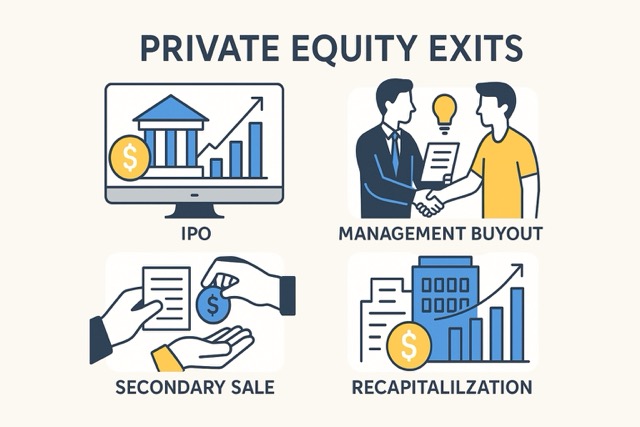When you’re managing a private equity investment, the exit is where your strategy is tested and your returns are realized. It’s not just about offloading a company at a decent valuation—it’s about choosing the exit route that aligns with timing, market dynamics, operational readiness, and investor goals. Whether you’re preparing for an IPO, negotiating a strategic sale, or pursuing a recapitalization, your ability to time the market, package the asset, and execute cleanly can mean the difference between a good return and an exceptional one. This article breaks down the primary exit strategies you need to understand, along with tactical considerations for maximizing your outcomes.
Public Market Exit: IPO as a Liquidity Event
If your portfolio company has achieved scale, shown consistent revenue growth, and built a compelling market narrative, taking it public might be your best option. An IPO provides access to public capital markets and often commands a higher valuation than private sales, particularly in hot sectors like technology or renewable energy. However, it’s not just about valuation—liquidity matters too. Listing the company allows partial exits over time through secondary offerings, and you can maintain a stake to benefit from future appreciation.
That said, timing and preparation are everything. You need a strong investor relations strategy, audited financials, and a clear use-of-proceeds narrative. The market also needs to be receptive. If the IPO window is tight or sentiment is weak, it might be smarter to pursue a sale or delay the listing.
Strategic Sale: Leveraging Buyer Synergies
Selling to a strategic acquirer is often the fastest and most lucrative route, especially when there’s a clear buyer who can unlock immediate synergies. These buyers typically pay a premium because they’re not just acquiring a business—they’re acquiring market share, technology, distribution channels, or talent.
If you’re eyeing this route, start early. Identify potential acquirers even before the exit is imminent. Understand what would make your company valuable to them—whether it’s access to a new customer segment or product cross-sell opportunities. And don’t underestimate the role of competitive tension. When multiple bidders are involved, valuation tends to rise. You’ll want advisors who can manage a tight process, keep momentum, and handle confidentiality throughout.
Secondary Buyout: Selling to Another PE Firm
In some cases, the best buyer is another private equity firm with a different investment thesis or a longer runway. Secondary buyouts are increasingly common and allow you to exit while providing the acquiring firm with a growth-ready platform. These deals tend to close faster than IPOs and often come with fewer regulatory hurdles.
You may use this strategy when growth potential remains but your fund’s investment period is nearing its end. A secondary buyer might specialize in expanding internationally, implementing operational efficiencies, or pursuing bolt-on acquisitions. If your portfolio company is solid but needs a fresh value creation plan, this could be a good outcome for everyone involved.
Management Buyout: Partnering with Insiders
When the existing leadership team wants to take the reins, a management buyout (MBO) becomes a viable path. This strategy is rooted in continuity and often driven by a strong internal belief in the business’s future. From your side, it provides a clean exit with a leadership team that already understands the company.
Structuring an MBO requires careful financing. The management team will likely need support from lenders or a new financial sponsor. You’ll also need to validate that the business has enough free cash flow to support the new capital structure. Because you’re negotiating with insiders, it’s important to run a fair, well-documented process that balances value with continuity.
Recapitalization: Taking Money Off the Table
You don’t always need to exit completely to return capital to your investors. Recapitalization allows you to restructure the company’s debt and equity to pull out liquidity while still holding a stake in the business. Dividend recapitalizations work best with companies that have stable, predictable cash flows.
This strategy is particularly useful when market conditions aren’t favorable for a full exit, or when you believe there’s more upside but still want to lock in partial gains. Be cautious, though. Over-leveraging the company in the process can strain operations and limit flexibility. Make sure you model repayment capacity conservatively.
Dual-Track Strategy: Creating Optionality
Preparing simultaneously for both an IPO and a sale is a smart way to maintain flexibility and generate leverage during negotiations. The mere presence of a dual-track process can encourage strategic bidders to move faster or offer more favorable terms, knowing you have another viable path.
To do this right, you’ll need a management team that can handle the disclosure and diligence requirements of both routes. You’ll also need advisors who can coordinate the process without confusing potential buyers or investors. If executed well, the dual-track approach puts you in control of the exit timeline and valuation discussions.
Exit by Liquidation: Cutting Losses with Discipline
Sometimes, exits don’t go as planned. If a portfolio company underperforms or market dynamics shift dramatically, liquidation may be your only option. This involves selling off the company’s assets and returning whatever proceeds remain to investors. It’s not the outcome you want, but it can limit further losses and free up capital for better opportunities.
The key here is to act quickly and efficiently. Avoid letting value erode further through indecision. If it’s clear the company can’t recover, engage restructuring professionals to preserve as much value as possible. Transparency with your LPs is also critical—they’ll respect a firm that takes decisive action rather than clinging to hope.
Key Exit Paths in Private Equity
- IPO: Access capital markets and partial liquidity
- Strategic Sale: Sell to an acquirer with synergy potential
- Secondary Buyout: Exit to another PE firm with fresh strategy
- Management Buyout: Transition control to company leadership
- Recapitalization: Return capital while retaining upside
- Dual-Track: Prepare for IPO and sale to increase flexibility
- Liquidation: Minimize losses when turnaround is unlikely
In Conclusion
Exiting a private equity investment is more than a final transaction—it’s the culmination of years of strategy, execution, and value creation. Your choice of exit path should reflect the company’s performance, market conditions, and investor expectations. From IPOs and strategic sales to recapitalizations and MBOs, each route has advantages when used at the right time. The key is to plan early, remain flexible, and be ready to pivot as opportunities emerge. When you manage exits with foresight and precision, you don’t just close a chapter—you set the stage for your next success.
Explore more thoughts and updates on Twitter: Follow their profile for tweets and insights.

Thomas J. Powell is a distinguished Senior Advisor at Brehon Strategies and a recognized figure in the realm of entrepreneurship and private equity. His journey in the financial services and banking sector, starting in 1988 in Silicon Valley, spans more than 35 years and is marked by profound industry expertise. Powell’s dual citizenship in the European Union and the United States empowers him to adeptly steer through international business landscapes. Currently studying for his Doctor of Law and Policy at Northeastern University, his research is centered on addressing the shortage of middle-income workforce housing in rural resort areas. Alongside his professional pursuits, he remains committed to community enrichment, illustrated by his 45-year association with the Boys and Girls Clubs of America. Follow Thomas J Powell on Twitter, Linkedin etc.

